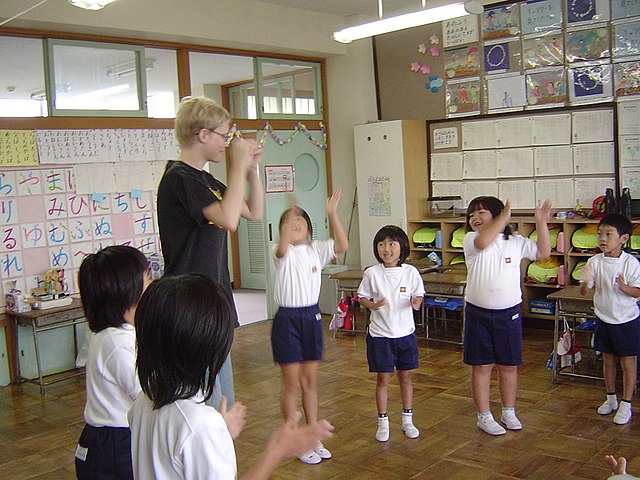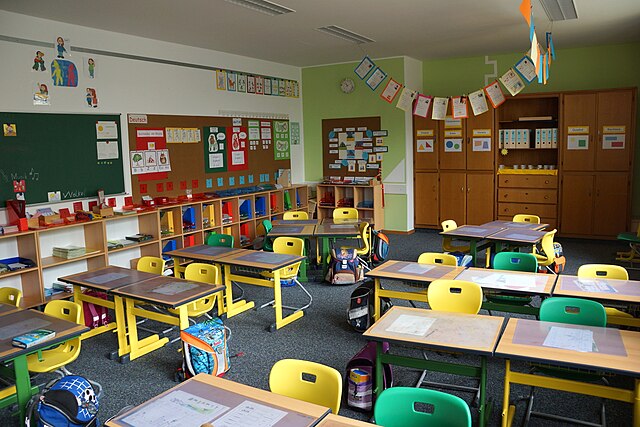Loading AI tools
School for children From Wikipedia, the free encyclopedia
A primary school (in Ireland, India, the United Kingdom,[1] Australia,[2] New Zealand,[3] Trinidad and Tobago, Jamaica, South Africa, and Singapore[4]), elementary school, or grade school (in North America and the Philippines) is a school for primary education of children who are 4 to 10 years of age (and in many cases, 11 years of age). Primary schooling follows preschool and precedes secondary schooling.




The International Standard Classification of Education considers primary education as a single phase where programmes are typically designed to provide fundamental skills in reading, writing, and mathematics and to establish a solid foundation for learning. This is ISCED Level 1: Primary education or first stage of basic education.[5]
| Level | Label | Description |
|---|---|---|
| 0 | Early childhood education (01 Early childhood educational development) | Education designed to support early development in preparation for participation in school and society. Programmes designed for children below the age of 3. |
| Early childhood education (02 Pre-primary education) | Education designed to support early development in preparation for participation in school and society. Programmes designed for children from age 3 to the start of primary education. | |
| 1 | Primary education | Programmes typically designed to provide students with fundamental skills in reading, writing and mathematics and to establish a solid foundation for learning. |
| 2 | Lower secondary education | First stage of secondary education building on primary education, typically with a more subject-oriented curriculum. |
| 3 | Upper secondary education | Second/final stage of secondary education preparing for tertiary education or providing skills relevant to employment. Usually with an increased range of subject options and streams. |
| 4 | Post-secondary non-tertiary education | Programmes providing learning experiences that build on secondary education and prepare for labour market entry or tertiary education. The content is broader than secondary but not as complex as tertiary education. |
| 5 | Short-cycle tertiary education | Short first tertiary programmes that are typically practically-based, occupationally-specific and prepare for labour market entry. These programmes may also provide a pathway to other tertiary programmes. |
| 6 | Bachelor's or equivalent | Programmes designed to provide intermediate academic or professional knowledge, skills and competencies leading to a first tertiary degree or equivalent qualification. |
| 7 | Master's or equivalent | Programmes designed to provide advanced academic or professional knowledge, skills and competencies leading to a second tertiary degree or equivalent qualification. |
| 8 | Doctorate or equivalent | Programmes designed primarily to lead to an advanced research qualification, usually concluding with the submission and defense of a substantive dissertation of publishable quality based on original research. |
This section needs additional citations for verification. (January 2024) |
Within the English speaking world, there are three widely used systems to describe the age of the child. The first is the "equivalent ages"; then countries that base their education systems on the "English model" use one of two methods to identify the year group; while countries that base their systems on the "American K–12 model" refer to their year groups as "grades". Canada also follows the American model, although its names for year groups are put as a number after the grade: For instance, "Grade 1" in Canada, rather than "First Grade" in the United States. This terminology extends into the research literature.[6][unreliable source]
In Canada, education is a provincial, not a federal responsibility. For example, the province of Ontario also had a "Grade 13", designed to help students enter the workforce or post-secondary education, but this was phased out in the year 2003.
| Equivalent ages | 4–5 | 5–6 | 6–7 | 7–8 | 8–9 | 9–10 | 10–11 |
|---|---|---|---|---|---|---|---|
| U.S. (grades) | Pre-K | K | 1 | 2 | 3 | 4 | 5 |
| Ireland | Junior Infants | Senior Infants | 1st Class | 2nd Class | 3rd Class | 4th Class | 5th Class |
| England (forms) | Reception | Infants | Top infants | Junior 1 | Junior 2 | Junior 3 | Junior 4 |
| England (year) | R | 1 | 2 | 3 | 4 | 5 | 6 |
| England (keystage) | EYFS/FS | KS1 | KS1 | KS2 | KS2 | KS2 | KS2 |
| Scotland | P1 | P2 | P3 | P4 | P5 | P6 | P7 |
| Jamaica | Pre-K | K-1 | Grade 1 | Grade 2 | Grade 3 | Grade 4 | Grade 5 |
| ISCED level | 0 | 1 | 1 | 1 | 1 | 1 | 1[6][unreliable source] |
| Indonesia[citation needed] | TK A | TK B | SD Kelas 1 | SD Kelas 2 | SD Kelas 3 | SD Kelas 4 | SD Kelas 5 |
| Equivalent ages | 11–12 | 12–13 | 13–14 | 14–15 | 15–16 | 16–17 | 17–18 |
|---|---|---|---|---|---|---|---|
| U.S. (grades) | 6 | 7 | 8 | 9 | 10 | 11 | 12 |
| Ireland | 6th Class | 1st Year | 2nd Year | 3rd Year | 4th Year | 5th Year | 6th Year |
| England (forms) | First | Second | Third | Fourth | Fifth | Lower Sixth | Upper Sixth |
| England (year) | 7 | 8 | 9 | 10 | 11 | 12 | 13 |
| England (keystage) | KS3 | KS3 | KS3 | KS4 | KS4 | KS5 | KS5 |
| Scotland | S1 | S2 | S3 | S4 | S5 | S6 | |
| Jamaica (forms) | First | Second | Third | Fourth | Fifth | Lower Sixth | Upper Sixth |
| Jamaica (grades) | 7 | 8 | 9 | 10 | 11 | 12 | 13 |
| ISCED level | 2 | 2 | 2 | 3 | 3 | 3 | 3[6][unreliable source] |
| Indonesia[citation needed] | SD Kelas 6 | SMP Kelas 7 | SMP Kelas 8 | SMP Kelas 9 | SMA Kelas 10 | SMA Kelas 11 | SMA Kelas 12 |



In most parts of the world, primary education is the first stage of compulsory education, and is normally available without charge, but may also be offered by fee-paying independent schools. The term grade school is sometimes used in the US, although both this term and elementary school may refer to the first eight grades, in other words both primary education and lower secondary education.[7][8][9]
The term primary school is derived from the French école primaire, which was first used in an English text in 1802.[10] In the United Kingdom, "elementary education" was taught in "elementary schools" until 1944, when free elementary education was proposed for students over 11: there were to be primary elementary schools and secondary elementary schools;[lower-alpha 1] these became known as primary schools and secondary schools.
In some parts of the United States, "primary school" refers to a school covering kindergarten through to second grade or third grade (K through 2 or 3); the "elementary school" includes grade three through five or grades four to six.[citation needed] In Canada, "elementary school" almost everywhere refers to Grades 1 through 6; with Kindergarten being referred to as "preschool."[citation needed]
Though often used as a synonym, "elementary school" has specific meanings in different locations.
School building design does not happen in isolation. The building (or school campus) needs to accommodate:
Each country will have a different education system and priorities.[20] Schools need to accommodate students, staff, storage, mechanical and electrical systems, support staff, ancillary staff and administration. The number of rooms required can be determined from the predicted roll of the school and the area needed.
According to standards used in the United Kingdom, a general classroom for 30 reception class or infant (Keystage 1) students needs to be 62 m2, or 55 m2 for juniors (Keystage 2).[21] Examples are given on how this can be configured for a 210 place primary with attached 26 place nursery[22] and two-storey 420 place (two form entry) primary school with attached 26 place nursery.[23]



The building providing the education has to fulfill the needs of: The students, the teachers, the non-teaching support staff, the administrators and the community. It has to meet general government building guidelines, health requirements, minimal functional requirements for classrooms, toilets and showers, electricity and services, preparation and storage of textbooks and basic teaching aids.[24] An optimum school will meet the minimum conditions and will have:
Government accountants having read the advice then publish minimum guidelines on schools. These enable environmental modelling and establishing building costs. Future design plans are audited to ensure that these standards are met but not exceeded. Government ministries continue to press for the 'minimum' space and cost standards to be reduced.
The UK government published this downwardly revised space formula for primary schools in 2014. It said the floor area should be 350 m2 + 4.1 m2/pupil place. The external finishes were to be downgraded to meet a build cost of £1113/m2.[25]
There are several main ways of funding a school: by the state through general taxation, by a pressure group such as a mosque or church, by a charity, by contributions from parents, or by a combination of these methods. Day-to-day oversight of the school can through a board of governors, the pressure group, or the owner.[citation needed]
The United Kingdom allows elementary education to be delivered in church schools, whereas in France this is illegal as there is strict separation of church and state.
This can be through informal assessment by the staff and governors such as in Finland, or by a state run testing regime such as Ofsted in the United Kingdom.[26]
Seamless Wikipedia browsing. On steroids.
Every time you click a link to Wikipedia, Wiktionary or Wikiquote in your browser's search results, it will show the modern Wikiwand interface.
Wikiwand extension is a five stars, simple, with minimum permission required to keep your browsing private, safe and transparent.